 |
 |
 |
| |
Metabolic Outcomes of ACTG 5142: A Prospective, randomized Phase III Trial of NRTI, PI, and NNRTI-sparing Regimens for Initial Treatment of HIV
|
| |
| |
Reported by Jules Levin
CROI, Feb 2007, LA
Summary: Lipoatrophy was more frequent in this study for patients taking EFV than for patients taking Kaletra as 32% of patients taking EFV + 2 nukes developed lipoatrophy after 96 weeks of therapy compared to 17% of patients taking Kaletra + 2 nukes who developed lipoatrophy after 96 weeks of therapy. EFV was associated with a 2.7 times increased risk of developing lipoatrophy when used with 2 nukes compared to Kaletra when used with 2 nukes. This difference was not affected by which nukes were used. Regardless of which nuke was used (d4T, tenofovir, AZT, and all patients added 3TC), the rates of lipoatrophy were double for patients taking efavirenz + 2 nukes compared to those taking Kaletra + 2 nukes. However, patients taking the NRTI sparing regimen of LPV/r + EFV had lower rates of lipoatrophy (9%) at week 96 compared to both EFV & Kaletra. All the differences were statistically significant. Tenofovir use was associated with the lowest rates of lipoatrophy compared to the other nukes used (d4T, AZT): 12% with EFV & 6% with Kaletra. While the rates of lipoatrophy associated with AZT use was 40% with EFV & 16% with LPV. The rates of lipoatrophy were highest with the use of d4T XR: 51% when used with EFV & 33% with LPV. Regarding lipids changes in total cholesterol and HDL (good cholesterol) were similar between EFV and Kaletra (with 2 nukes). HDL chol changes were similar for both EFV & Kaletra. But triglycerides increased more for patients taking Kaletra compared to EFV. The nuke sparing regimen of Kaletra+EFV had the highest increase in total cholesterol and triglyercides, but also had greater increase in the good cholesterol HDL.
The authors concluded "selection between DHHS recommended regimens containing EFV vs LPV should consider the differential effects on many factors including lipids and body fat distribution".
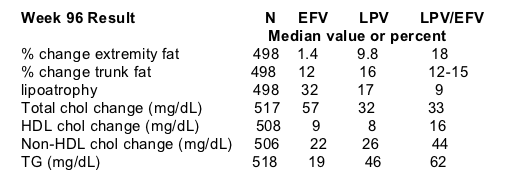
Richard Haubrich reported these study results for the ACTG. The metabolic objectives of this sub-analysis was to compare changes in body fat, including the occurrence of lipoatrophy (defined as >/= 20% loss of extremity fat) between treatment arms and by NRTI; and to compare changes in total, HDL, and non-HDL cholesterol and triglycerides between treatment arms and by NRTI selection.
Patients were randomized to:
Kaletra 533/133 SGC bid + EFV
Or
Kaletra 400/100 SGC bid + 2 nukes
Or EFV QD + 2 nukes
3TC plus AZT, d4T XR, or TDF were used.
The viral efficacy results were reported at IAS in Toronto this past summer.
Time To Virologic Failure
They also reported Kaletra had benefits related to resistance development.
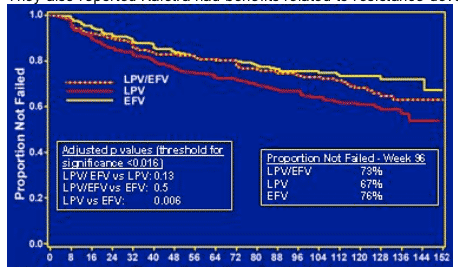
This subanalysis measured DEXA at week 0, 48, and 06. Fasting lipids were measured at 0, 12, 48, 72, and 96. The analysis was ITT, with no censoring for regimen change or use of lipid lowering medications. AT and sensitivity (accounting for lipid lowering medications) analysis produced similar results.
BASELINE CHARACTERISTICS
20% female
64% non-white
age: 38
CD4 median: 191
HIV RNA >100,000: 51%
NRTI use: AZT 42%, d4T XR: 24%, TDF: 34%
BASELINE METABOLIC PARAMETERS
Lipid values were similar at baseline across all 3 treatment groups:
Total chol (mg/dL): 152-153
HDL: 34-36
Non-HDL: 116-119
LDL: 90-93
TG: 112-118
EXTREMITY FAT (kg): 7.2 in EFV, 6.7 in LPVr, 7.1 in LPV/r/EFV
TRUNK Fat (kg): 8.3 in EFV, 8.0 in LPV/r, 8.2 in LPV/r=EFV
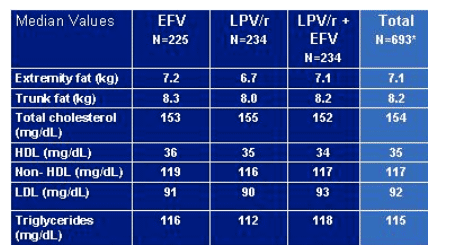
Lipoatrophy Changes: median Percent Change From Baseline in Extremity Fat
Extremity fat increased from baseline to week 48 in all treatment groups. But after week 48 the responses change for patients in each group. The median percent change in extremity fat was an increase of 18% from baseline to week 96 for the EFV/Kaletra group (nuke sparing); an increase of 9.8% in the Kaletra + 2 nukes group; for the EFV group + 2 nukes groupfat increased by 8% from baseline to week 48 which might be due to improved health for patients due to HAART, but from week 48 to week 96 fat decreased back to baseline. The absolute changes in fat were 1 kg gain in nuke sparing arm. 0.7 kg gain in Kaletra arm, and 0.5 kg gain in the EFV arm.

Pairwise comparisons of all the groups were statistically significant:
P_values at week 96 --
LPV/EFV vs LPV: 0.013
LPV/EFV vs EFV: <0.001
LPV vs EFV: 0.007
Trunk fat increased 12-16% and was not different across randomized groups, p>0.05.
LIPOATROPHY (>20% loss Extremity Fat)
From week 0 to week 48, 21% taking EFV/2 nukes, 10% taking Kaletra+2 nukes, and 7% taking EFV/LPV-r developed lipoatrophy. At week 96 these numbers had increased with 32% taking EFV/2 nukes, 17% taking LPV+2nukes, and 9% taking LPV+EFV developing lipoatrophy.
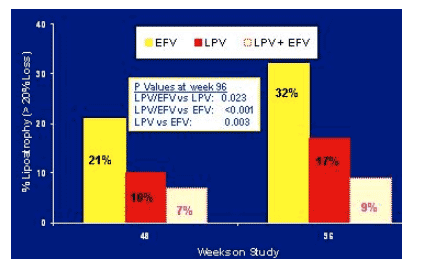
All pairwise comparisons at week 96 were statistically significant:
P values at week 96:
LPV/EFV vs LPV: 0.023
LPV/EFV: <0.001
LPV vs EFV: 0.003
Lipoatrophy (NRTI arms only)
Patients taking d4T XR were more likely to develop lipoatrophy: 26% by week 48, 42% by week 96. Patients taking AZT: 16% developed lipoatrophy by week 48 and this increased to 27% at week 96. Tenofovir had the most favorable with 8% on this drug developing lipoatrophy by week 48 and 9% by week 96.

All pairwise comparisons were statistically significant.
P values at week 96:
AZT vs TDF: <0.001
D4T vs TDF: <0.001
D4T vs AZT: 0.038
Percent with Lipoatrophy Based on NRTI Used: 2 fold more lipoatrophy for patients taking EFV compared to Kaletra
Before seeing the study results many conference attendees of whom I spoke with at meeting did not believe the study results and figured the worse EFV lipoatrophy compared to Kaletra would be due to more use of d4T by EFV users. But the data did not support this. In this table you can see that regardless of which nuke was used twice as many patients taking EFV developed lipoatrophy than for patients taking Kaletra:
D4T+EFV: 51% developed lipoatrophy
LPV+d4T: 33%
AZT+EFV: 40%
AZT+LPV: 16%
EFV+TDF: 12%
LPV+TDF: 6%
TOTAL: 32% EFV, LPV 17%
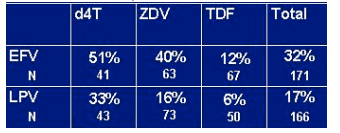
A logistic regression analysis was performed to establish independence between these groups that included 2 factors—randomized arm and NRTI. So they could say after controlling for selected nucleoside used EFV had an odds of lipoatrophy of 2.7 times that for Kaletra (OR 2.7, 95% CI 1.504.6, p <0.001); d4T was 1.9 times more likely to cause lipoatrophy (OR 1.9, 95% CI 1,1-3.5, p=0.029); and tenofovir was much less likely to cause lipoatrophy (OR 0.24, 95% CI 0.12-0.5, p<0.001).
Median Change in Total Cholesterol (mg/dL)
The benefits of loss lipoatrophy by using LPV/EFV nuke sparing resulted in a cost of more increased total cholesterol: LPV-r/EFV had increase in total cholesterol of 57 at week 96 from baseline with most of the increases occurring in the first 12 weeks as with the other two treatment groups. Patients taking Kaletra had an increase of 32 at week 96 and patients taking EFV had an increase of 33. The pairwise comparisons showed that the difference in total cholesterol changes between LPV/EFV vs LPV or EFV was statistically significant. Use of lipid lowerting medcations showed similar results: at 96 weeks 25% and 11% & 13% in these arms, respectively used lipid lowering medications.
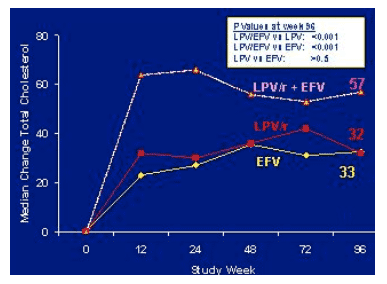
Median Change in Triglycerides (mg/dL)
The nuke sparing arm LPV+EFV showed the gretest increase in TG with an increase of 62 at week 96; LPV/r had an increase of 46, and patients taking EFV had a median increase of 19 at week 96. And as you can see in the graph difference between each group were statistically significant.
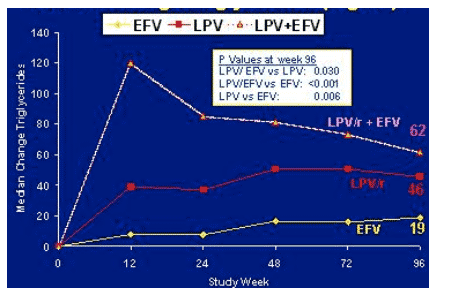
Additional Week 96 Lipid Results
Increases in both HDL & non-HDL cholesterol were significantly greater in the NRTI-sparing (16 and 44 mg/dL) compared to the 2 NRTI-containing regimens (P<0.001). On the other hand, increases in both HDL & non-HDL cholesterol were not different between 2 NRTI+LPV/r (8 and 26 mg/dL) or EFV (9 and 22 mg/dL, p>0.3). Lipid increases were less different across selected NRTI, but note d4T containing regimens tended to have higher total cholesterol, non-HDL cholesterol and triglyceride increases than TDF-containing regimens (p<0.05)
|
| |
|
 |
 |
|
|